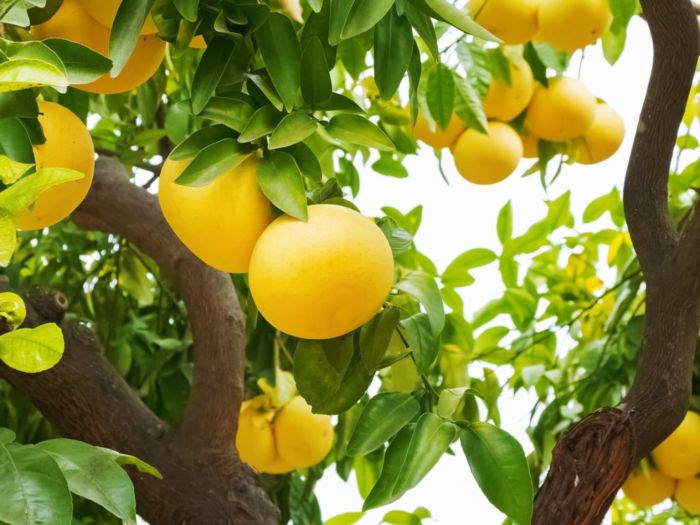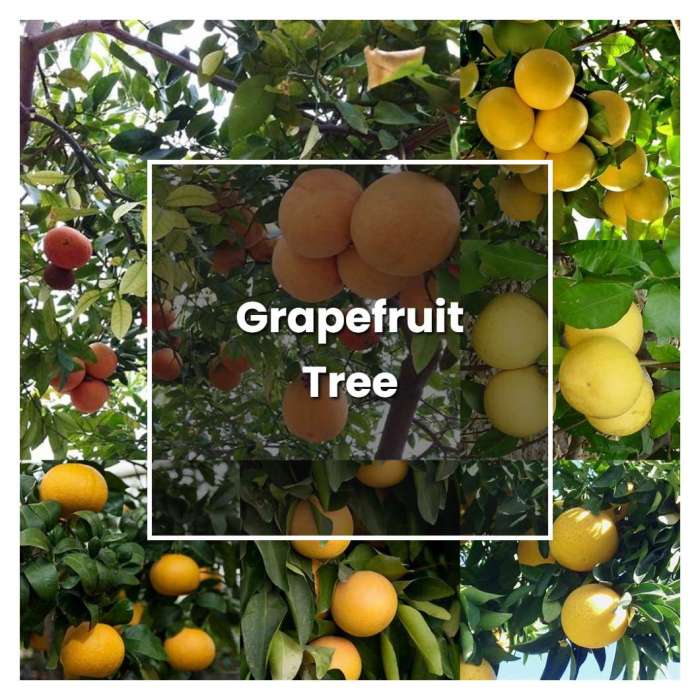Choosing the Right Grapefruit Tree

How to plant a grapefruit tree – Choosing the perfect grapefruit tree for your Balinese paradise is crucial for a bountiful harvest. Consider your climate, space, and desired fruit characteristics before making your selection. Let’s dive into the details to help you find your perfect match!
Planting a grapefruit tree starts with choosing a sunny spot and well-draining soil. To ensure you’re selecting the right tree for Houston’s climate, check out this helpful guide on the best trees to plant in houston , as grapefruit thrives in warm conditions. After selecting your tree, dig a hole twice the size of the root ball and gently place the tree, ensuring the graft union is above ground.
Water deeply and regularly.
Grapefruit Tree Varieties
Selecting the right grapefruit variety depends on several factors including the size of your garden, your preferred taste, and your local climate. Here’s a comparison of some popular options:
| Variety | Size (Mature Height) | Fruit Characteristics | Cold Hardiness (USDA Zones) |
|---|---|---|---|
| Rio Red | 15-20 feet | Large, deep red flesh, sweet and juicy, low acidity | 9-11 |
| Star Ruby | 15-20 feet | Medium-sized, ruby red flesh, sweet and tart, good for juicing | 9-11 |
| Marsh Seedless | 15-25 feet | Large, yellow flesh, juicy, slightly tart, seedless | 9-11 |
| Oro Blanco | 15-20 feet | Large, white flesh, sweet and mild, less acidic than red varieties | 9-11 |
Ideal Climate and Soil Conditions
Grapefruit trees thrive in warm, sunny climates with ample sunlight. They need at least six hours of direct sunlight per day. Bali’s tropical climate is generally well-suited for grapefruit cultivation. Well-drained soil is essential; heavy clay soils can lead to root rot. A slightly acidic soil pH (6.0-6.5) is ideal.
Adding organic matter, such as compost, will improve soil drainage and fertility. Regular watering is crucial, especially during dry periods, but avoid overwatering which can lead to root problems.
Bare-Root vs. Container-Grown Trees
The choice between a bare-root and a container-grown tree involves considering several factors. Bare-root trees are generally less expensive, but require more careful handling and planting. They also have a slightly higher risk of transplant shock. Container-grown trees, while more expensive, are easier to handle and transplant, and have a higher survival rate. They are also more established and can fruit sooner.
For a beginner, a container-grown tree is often the easier and more reliable option, minimizing the risk of failure in the initial planting phase. Think of it like choosing between surfing a beginner’s wave versus tackling a big one right away – you want to set yourself up for success!
Harvesting and Storing Grapefruit

So, you’ve nurtured your grapefruit tree, and now it’s time for the sweet rewards – juicy, sun-kissed grapefruit! Harvesting and storing your bounty correctly ensures you get the most delicious fruit possible, extending its vibrant flavor and minimizing waste. Think of it as giving your hard work the ultimate Balinese spa treatment – preserving its freshness and extending its enjoyment.
Identifying Ripe Grapefruit, How to plant a grapefruit tree
Knowing when your grapefruit is ready for picking is key. Harvesting too early results in tart, underdeveloped fruit, while waiting too long can lead to overripe, less flavorful grapefruit. Here’s how to tell if your grapefruit is perfectly ripe:
- Color: The color of ripe grapefruit varies depending on the variety. Some varieties turn a deep, vibrant yellow or orange, while others remain greenish-yellow even when ripe. Look for a consistent color across the fruit, avoiding those with green patches that indicate under-ripeness. A slight blush of color often indicates sweetness.
- Feel: Gently squeeze the grapefruit. A ripe grapefruit will feel firm but give slightly to gentle pressure. Avoid those that feel rock-hard (underripe) or overly soft (overripe).
- Weight: A ripe grapefruit will feel heavier for its size than an unripe one. This is because the fruit has filled out with juice.
- Aroma: A subtle, sweet citrus aroma should be present near the stem end of a ripe grapefruit. A strong, almost alcoholic scent may indicate overripeness.
Safely Harvesting Grapefruit
Harvesting grapefruit requires a gentle touch to avoid damaging the fruit and the tree itself.
Use sharp pruning shears or clippers to cut the grapefruit from the branch. Avoid pulling or twisting the fruit, which can damage the branch and the fruit. Make a clean cut about ½ inch from the stem. This minimizes the risk of infection or disease.
Inspect the fruit for any blemishes or damage after picking. Discard any that show signs of disease or insect infestation.
Wear gloves to protect your hands from thorns or rough skin. If harvesting from a tall tree, use a sturdy ladder or pole pruner to reach the higher branches, ensuring your safety.
Storing Harvested Grapefruit
Proper storage is essential for maintaining the quality and freshness of your grapefruit harvest.
At room temperature, grapefruit can last for about a week. However, refrigeration is the best method for extending its shelf life. Store grapefruit in a plastic bag or container in the refrigerator’s crisper drawer, where the humidity is controlled. This can extend its freshness for up to three weeks.
Avoid storing grapefruit near strong-smelling foods as they can absorb the odors. Furthermore, don’t wash the grapefruit until you’re ready to eat it; washing before storage can accelerate spoilage.
Troubleshooting Common Problems

Hey, fellow plant papas and mamas! Growing grapefruit trees in Bali’s awesome climate is mostly a breeze, but even the chillest vibes can get a little bumpy sometimes. Let’s troubleshoot some common issues so your citrus dreams stay juicy and bright. Think of this as your ultimate guide to keeping those grapefruit trees happy as clams.
Grapefruit trees, like all living things, can face challenges. Understanding these problems and knowing how to address them organically or conventionally will keep your trees thriving and producing those delicious, sun-kissed fruits. Remember, a little preventative care goes a long way!
Blossom Drop
Blossom drop, where flower buds fall off before fruit sets, is a common issue. This can be caused by several factors including stress from insufficient watering, nutrient deficiencies (especially potassium and phosphorus), or extreme temperature fluctuations. Addressing these factors is key. For example, ensuring consistent watering, particularly during the flowering period, is crucial. A regular fertilization schedule using a balanced citrus fertilizer can provide the necessary nutrients.
Consider using organic options like compost tea or seaweed extract to boost nutrient availability and soil health. Conventional methods might involve using chemical fertilizers with higher concentrations of potassium and phosphorus. Both approaches aim to provide the tree with the resources it needs to support fruit development.
Yellowing Leaves
Yellowing leaves, or chlorosis, often signals a nutrient deficiency, typically iron or magnesium. Poor drainage can also contribute to this problem. To remedy this, consider soil testing to determine the exact nutrient deficiencies. If iron is lacking, chelated iron supplements can be applied either through the soil or as a foliar spray (directly onto the leaves). Organic methods include using iron-rich compost or mulching with materials that improve soil drainage and aeration.
Conventional solutions may involve synthetic iron chelates, offering quicker results. Magnesium deficiency can be addressed similarly, using Epsom salts (magnesium sulfate) as an organic solution, or a commercial magnesium supplement conventionally. Improving soil drainage is crucial in both approaches, ensuring the roots can access nutrients efficiently.
Fruit Splitting
Fruit splitting is often caused by inconsistent watering, leading to rapid fruit growth followed by periods of water stress. This causes the fruit skin to rupture. Maintaining consistent soil moisture is vital, especially during fruit development. Mulching around the base of the tree helps regulate soil moisture. Organic practices focus on building healthy soil that retains moisture better, while conventional methods may involve using irrigation systems for more precise water management.
Proper pruning can also help by reducing stress on the tree and improving air circulation, preventing excessive moisture buildup.
FAQ Summary: How To Plant A Grapefruit Tree
Can I grow a grapefruit tree in a pot?
Yes, but choose a dwarf variety and a large, well-draining pot. Regular fertilization and watering are crucial.
How often should I prune my grapefruit tree?
Prune lightly in late winter or early spring to remove dead or damaged branches and shape the tree. Avoid heavy pruning.
What are the signs of a ripe grapefruit?
Look for a deep, consistent color (depending on the variety), slightly soft skin when gently squeezed, and a pleasant aroma.
My grapefruit leaves are yellowing. What’s wrong?
Yellowing leaves can indicate nutrient deficiencies (especially iron), overwatering, or pest infestations. Check your soil and inspect for pests.
